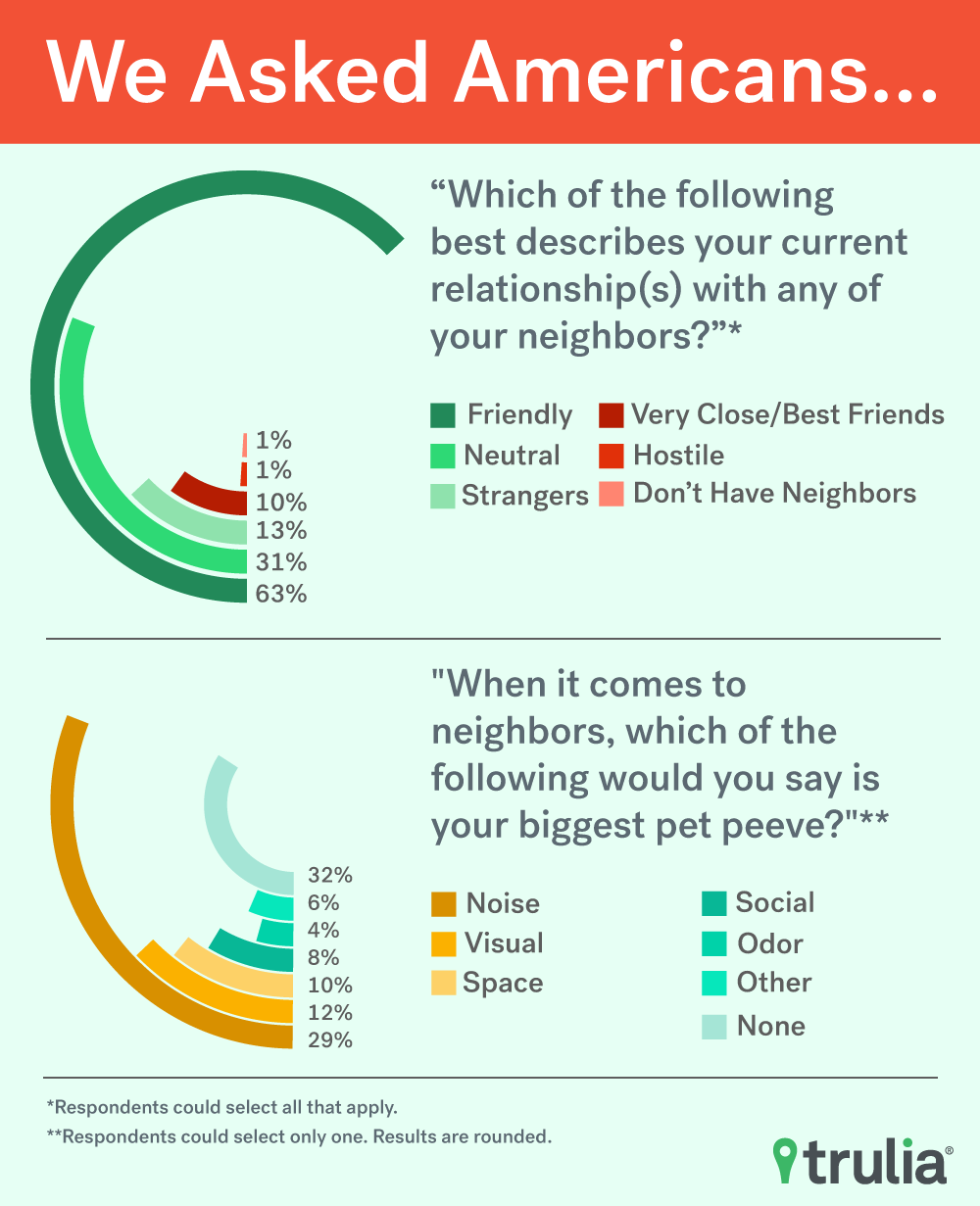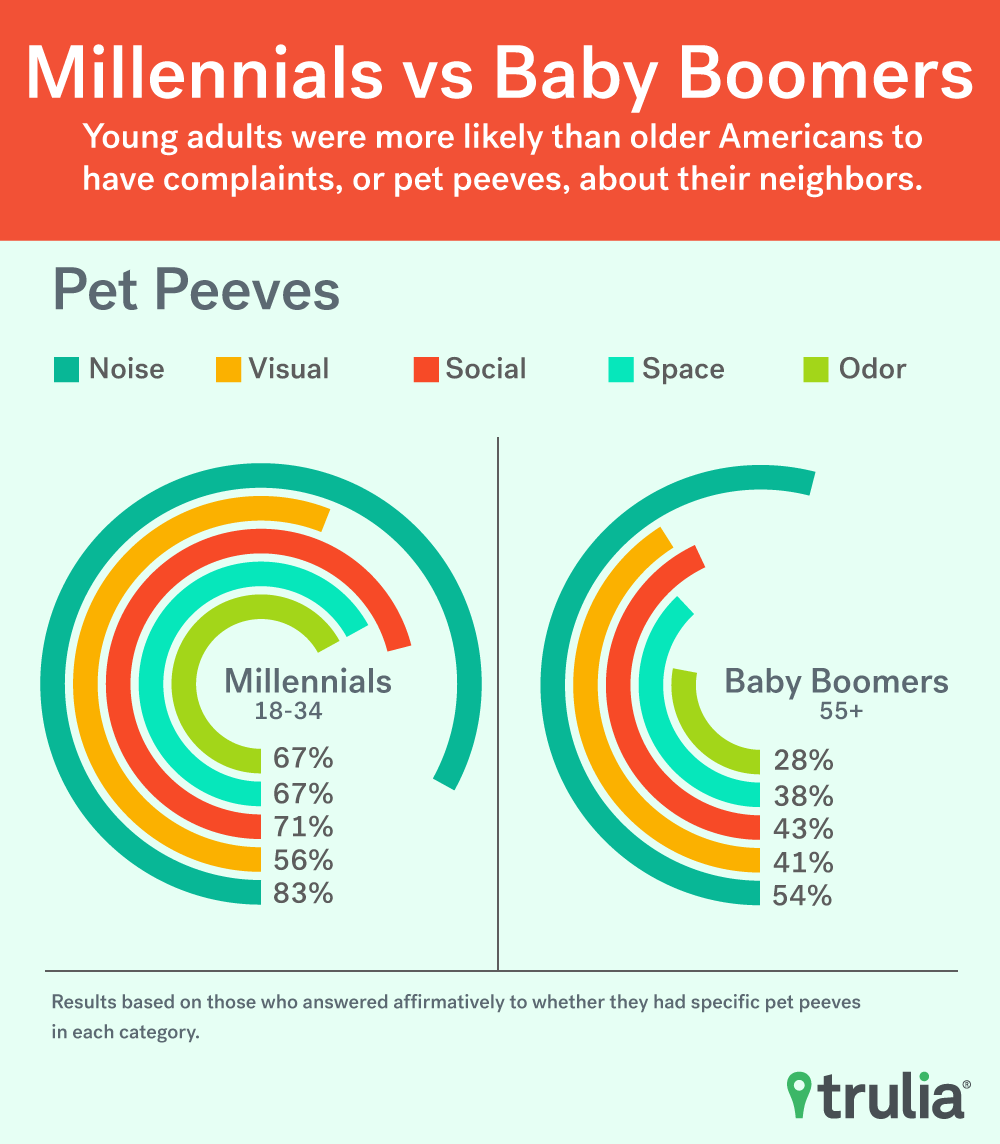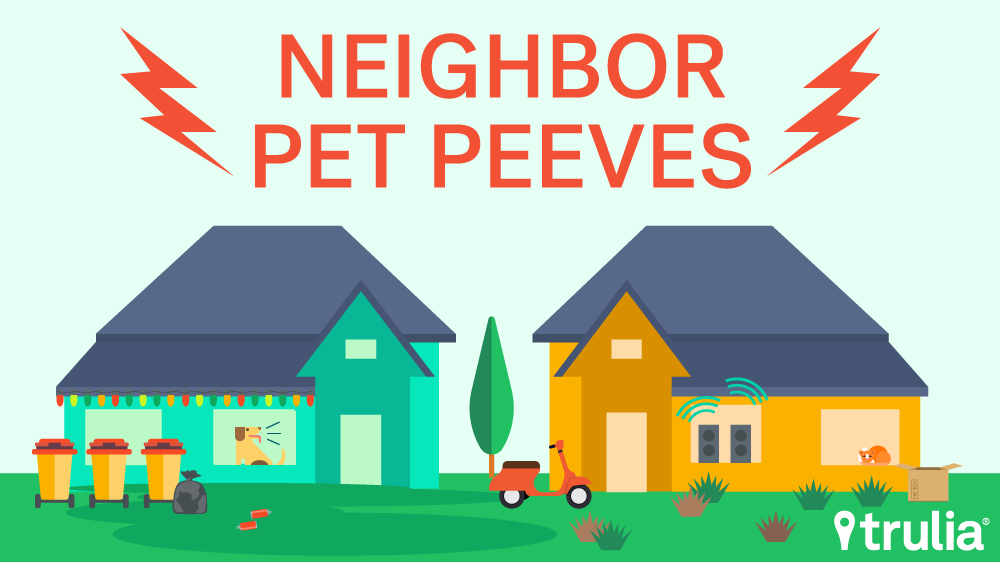Can’t we all get along? Actually we do — mostly.
Despite a national discussion that suggests we’ve become a nation divided, the reality is when it comes to our neighborhoods we get along pretty well – even if we do bother one another from time to time.
We found that a majority of Americans are friendly with their neighbors and know them on a first name basis, but most people still admit to having pet peeves with their neighbors. Younger Americans, particularly millennials and Gen Xers, are the most sensitive and confrontational neighbors, suggesting that the “get off my lawn!” attitude associated with older baby boomers may be largely a myth.
It seems that everyone either has, or knows someone with, a horror story about their neighbors, evoking fears about nightmare neighbors. But how do Americans actually perceive their neighbors? What are the pet peeves about our neighbors that drive us nuts? Who makes a good neighbor and who doesn’t?
It turns out that most Americans get along with their neighbors. When asked to describe their relationship to their neighbors, 63% of Americans characterized their relationship as “friendly” and 10% considered their neighbors to be “very close” or even “best friends,” according to an online survey conducted by Harris Poll on behalf of Trulia. The survey was conducted from September 14-16, 2016 among 2,069 adults ages 18 and over. Additionally:
- Over half (61%) of Americans who have neighbors know the first names of most of their immediate neighbors.
- Given the relative harmony between neighbors, it is not surprising that only 1% of Americans described their relationship with their neighbors as hostile.
- Millennials (ages 18-34) tend to either be very close or complete strangers with their neighbors. Sixteen percent of millennials consider themselves very close or best friends with their neighbors compared to 10% of Gen Xers (ages 35-54) and 6% of baby boomers (ages 55+), and 24% of millennials describe their relationship with neighbors as strangers compared to 12% of Gen Xers and just 6% of baby boomers.
- Difficult neighbors are a source of concern for many, since nearly one in five (18%) Americans said that having a difficult neighbor would motivate them to move.
Despite generally positive sentiments towards neighbors, most Americans (68%) still griped about neighbor pet peeves and nearly half of Americans (49%) experienced a problem with a neighbor in the past 12 months. More than half (56%) of those who had issues with neighbors cited noise problems, for example loud music, pet noise, and loud parties. Visual or aesthetic issues, such as poor yard conditions, were a distant second (28%) in terms of neighbor related problems.

When it comes to neighbors, which of the following would you say is your biggest pet peeve? (Top three listed.)
| Noise-related | Visual/aesthetic-related | Social-related | Space-related | Odor-related |
| 1. Loud music 2. Pet noise 3. Loud parties |
1. Poor yard conditions 2. Too many cars in driveway 3. Ugly paint |
1. Nosy neighbors 2. Bad pets 3. Hostile/ threatening neighbors |
1. Dog poop on lawn/in trash 2. Too many/ disrespectful guests 3. Overgrowth of trees/ plants |
1. Trash 2. Cigarette smoke 3. Marijuana smoke |
Among Americans who have experienced a problem with a neighbor in the past 12 months, more than half (56%) say they ignore it, but of those that do act, most (62%) choose to speak directly to their neighbor to resolve the issue, either in person or over the phone. More than one-third (35%) relied on third-party mediation and contacted authorities when facing an issue with neighbors. In a few instances, some people took more extreme measures by retaliating (10%) or actually moving away to escape a problem neighbor (6%).
The Sharing Generation?
Neighbor pet peeves and reactions to neighbor problems are not the same for all Americans. Age and generational differences appear to have a strong influence on what irks people and how they respond to problematic neighbors. Contrary to the popular stereotype of low-tolerance baby boomers, 63% of those 55 years of age or older reported having no problems with neighbors in the last 12 months. On the other hand, more than half of millennials (61%) and Gen Xers (52%) encountered issues with their neighbors in the last year.
Millennials were the most sensitive age group across all types of pet peeves when it comes to neighbors. Over 4 in 5 millennials (83%) claimed to have noise-related pet peeves compared to just two-thirds of the general adult population (67%). This is not surprising given that millennials are younger and tend not to own their home at this stage of their lives. Millennials, for example, comprise a much higher share of renters (52%) than Gen Xers (37%) and baby boomers (22%), which likely suggests they are living in closer quarters with others and may be more susceptible to neighborly annoyances. Indeed, Trulia research finds that millennials also tend to live in housing units that are likely to place them closer to more neighbors. Specifically, 27% of millennials live in either apartments or condominiums compared to 19% of Gen Xers and 16% of baby boomers. Renters as a whole are more likely to have experienced noise (37%) and odor (10%) issues compared to homeowners (22% and 5%, respectively) and seem to be less familiar with their neighbors as they are more than twice as likely to characterize their relationship with their neighbors as “strangers” (19%) compared to homeowners (9%).

What is your biggest pet peeve when it comes to neighbors? Percentages having listed type of pet peeve:
| Pet Peeve | Millennial | GenX | Baby Boomer | Total Population |
|---|---|---|---|---|
| Noise | 83% | 71% | 54% | 67% |
| Visual | 56% | 54% | 41% | 50% |
| Social | 71% | 57% | 43% | 56% |
| Space | 67% | 53% | 38% | 51% |
| Odor | 67% | 49% | 28% | 46% |
In addition to generational differences in pet peeves when it comes to neighbors, family structure and income appear to dictate how peeved people may be by their neighbors. Those with children in the household were almost two and a half times more likely to experience a space-related issue in the last year than those without, 14% versus 6%. Americans who make $100,000+ per year are more likely than those who make less than $50,000 per year to experience visual/aesthetic related issues with neighbors, 19% versus 11%, respectively. While fewer higher income earners seemed to have experienced issues with neighbors in the past year, more Americans earning more than $100,000 a year experienced visual or aesthetic issues than the general population, 19% versus 14%, respectively.
Why ‘Get Off My Lawn’ May Be A Myth
Millennials and Gen Xers reacted most strongly to problems with neighbors, while women and those who are retired tended to ignore problematic neighbors. Millennials and Gen Xers, however, handled their beef with neighbors in different ways. More Gen Xers who have experienced a problem with a neighbor in the past 12 months (29%) chose in-person dialogue to sort out issues with neighbors compared to millennials (19%). Millennials, on the other hand, relied on third-party mediation by contacting authorities at a rate twice that of baby boomers (20% versus 10%).
Overall, women who experienced a problem with a neighbor in the past 12 months tended to do nothing when encountering issues with neighbors, with 63% choosing to ignore problems with neighbors compared to 48% of men. Moreover, millennial women were the most passive group with 70% ignoring problems with neighbors compared to millennial men who had the lowest portion of ignorers at 33%. Retirees are also more laid back when it comes to those who have experienced a problem with a neighbor in the past 12 months compared to their employed counterparts, with 62% retirees choosing to ignore issues with neighbors compared to 51% of those that are employed. No retirees retaliate when they encounter problems with neighbors, but 7% of employed people take matters into their own hands.
What is your biggest X-related pet peeves when it comes to neighbors? Percentages having listed type of pet peeve:
| Men | Women | Employed | Retired | |
| *Denotes that the differences between comparison groups are not statistically significant. | ||||
| Ignored it | 48% | 63% | 51% | 62% |
| Spoken with neighbors (in person or over the phone) | 31% | 24% | 31%* | 24%* |
| Contacted authorities | 17%* | 14%* | 17% | 9% |
| Considered moving away | 11%* | 9%* | 12% | 5% |
| Sought help from other neighbors | 13% | 3% | 10% | 5% |
| Email or texted neighbors to sort it out | 11% | 4% | 11% | 1% |
| Retaliated | 7% | 2% | 7% | 0% |
| Moved away | 4%* | 2%* | 4% | 0% |
More Findings:
- Happy Holidays: just 6% of Americans consider holiday decorations left out well past the holidays a visual-related pet peeve when it comes to neighbors.
- 15% of Americans say that arguing is among their biggest noise-related pet peeves; renters are more than twice as likely to feel this way as homeowners (23% vs. 11%, respectively).
- Just 7% of Americans inquire about neighbors before moving to a new home.
- Half of those who have “space-related” pet peeves when it comes to neighbors (51%) said dog poop left in their yard or trash by a neighbor was a pet peeve.
- Renters are twice as likely as homeowners to say noisy children are a noise-related pet peeve when it comes to neighbors (20% versus 10%, respectively).
- A far greater share of those who are married (70%) consider their relationship to the neighbors as friendly as those who are not married (54%).
- One in ten of those who are married (10%) characterize their relationship with their neighbors as strangers whereas more than one in six (17%) of those that are not married see their neighbors as strangers.
- More than half (53%) of those who are married claim to be irritated by visual related issues, whereas 46% of unmarried people would be annoyed by neighbors’ aesthetic choices. Poor yard conditions (35%) and too many cars in the driveway (18%) were particularly irksome to married people.
- Renters (32%) are more than twice as likely as homeowners (15%) to be peeved by the smell of trash when it comes to odor related issues with neighbors.
- More educated people are bothered by social-related pet peeves; 58% of those with at least a college degree have social-related pet peeves when it comes to neighbors compared to 49% of those with a high school degree or less.
- Those with at least a college degree are also more likely to have visual-related pet peeves when it comes to neighbors (55% versus 42% of those with high school degrees or less). Poor yard conditions are particularly bothersome to college grads. Thirty-five percent of them considered them a pet-peeve, while 24% of high school educated or less considered this an issue.
- The reputation of welcoming and friendly Midwesterners appears largely true. About two-thirds of Midwesterners (68%) know their neighbors by first name, higher than any other region. The region with the second highest level of familiarity with neighbors is the Northeast, where 61% of people know neighbors by their first name, followed by Southerners (59%) and Westerners (57%).
Methodology
This survey was conducted online within the United States by Harris Poll on behalf of Trulia from September 14-16, 2016 among 2,069 adults ages 18 and older. The online survey is not based on a probability sample and therefore no estimate of theoretical sampling error can be calculated. For complete survey methodology, including weighting variables and subgroup sample sizes, please contact dweidner@trulia.com.
Millennials are defined as those under the age of 35, Generation Xers are defined as those between the ages of 35 and 54, and baby boomers are those that are aged 55 or older.


